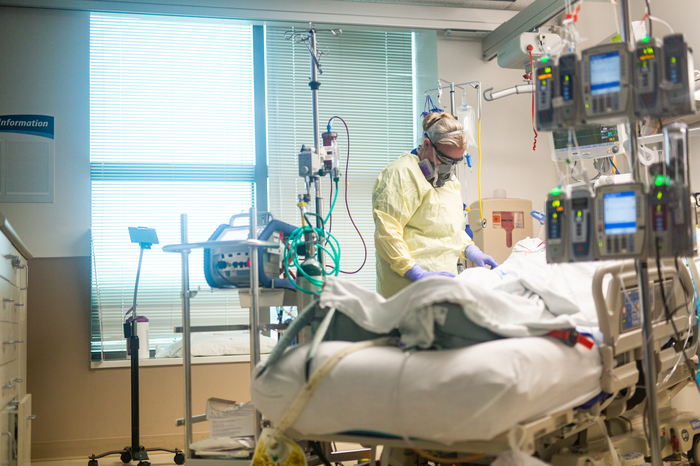How hospital is preventing staff burnout amid pandemic stress

A worker at Carilion Roanoke Memorial Hospital holds equipment in the COVID-19 unit. Courtesy of Carilion Clinic.
Dr. Lisa Uherick has a big job these days. She’s a pediatric doctor for the emergency room at Carilion Roanoke Memorial Hospital in Virginia. She’s also the head of well-being for Emergency Services, meaning it’s her job to make sure 1,300 hospital employees find healthy ways to deal with stress.
In the first year of the pandemic for the Virginia hospital system, no amount of email communication about self-care, or reminders to take vacation days, were working.
“One of our doctors came to say to me, ‘I can do all the yoga, but if I come to work and there’s not enough staff to take care of the patients that are under my watch, I can’t be healthy. I’m not the problem; the system is the problem,’” she said.
She calls that conversation an “aha moment,” one that fundamentally changed the way she viewed stress and burnout in the ER.
“The beginning of this work has to start with us telling people they individually matter,” she said.
Across the country, workers in the medical field are leaving en masse and hospitals are desperate. More than half of departing workers report being burned out, according to a USA Today/Ipsos survey, and 32% of nurses say they are thinking about leaving their jobs.
The problem of physician stress gained national attention following the death of Dr. Lorna M. Breen, who died by suicide in April 2020 at her family’s Charlottesville home.
The stark numbers led the Carilion Clinic to re-evaluate its wellness program, which was already several decades old. One of its most successful endeavors: place counselors in the hospital who can respond immediately during a crisis.
When a nurse loses a young patient or has an altercation with an aggressive family member, Chad Runyon, or another licensed counselor with Carilion’s Employee Assistance Program (EAP), gets called. They introduce themselves in person and hand out business cards.
“Sometimes it’s hard to remember all the people they’ve saved because they’re not seeing that in the moment,” Runyon said. “The way we respond … reaches people that wouldn’t have reached out. When we show up in the flesh, they’re more likely to use (the EAP program).”

While many workplaces have EAP programs where employees can call if they need to talk, Runyon said showing up where an incident happened has made a huge difference. Carilion also increased the EAP program from three to five sessions per life event.
Increasing the number of sessions and on-site counselors resulted in approximately 300 extra hours of services used since October of 2021, according to the hospital.
Carilion workers reported higher well-being despite pandemic stressors, according to a self-reported annual employee survey. That’s a key measurement predicting retention, a hospital spokesperson said. Still, inpatient nurses reported less well-being than other workers, likely a result of their intimate interactions with patients.
Normalizing mental health struggles is essential to intervening with repeatedly stressed employees, said Jennifer Moss, the author of “The Burnout Epidemic.” And that comes from culture change developed over time.
“Instead of giving someone an app and saying use this because it will help you sleep better, we should be making sure that we have … more conversations about mental health at work,” Moss said. “In the pandemic, we found that 67% of people could not talk about mental health at work — and of that 67%, they were always or often burned out.”
While Carilion admits there is still more to do when it comes to reducing stress, Uherick said she has started to see that culture change. The hospital system recently launched an employee-led wellness committee and is starting a system to better track whether initiatives are working.
“I’ve started to see a common language that people can talk about, like making sure we have a culture of encouragement, not being afraid to say when you’re tapped out,” she said. “When I look at our data and see the team is more burned out (than last year), I think, ‘Thank goodness we started when we did.’”














